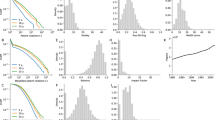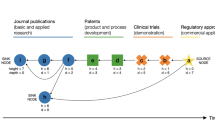Abstract
Biotechnology is an expanding interdisciplinary field in which the interactions of science and technology (S&T) are more and more intensified. Question raised regarding the dynamic interactions between S&T encourages us to propose a series of methodologies for examination. Using high-impact publications and patents as the proxy measures, two document sets are transformed into the scientific and technical front trajectories respectively, and then each subject is categorized into either basic science, or applied technology, or co-existence. The results show that, in the biotechnology field, subjects of embryonic or mesenchymal stem cells, RNA interference, microRNA, and microbial fuel cell are in the basic science phase; those of plant breeding, seed diversity, and taste receptors have been applied to practice. There also exists interactions between S&T in the subjects of disease treatment and gene analysis platform, in which the behavior of technology precedes science, science precedes technology, or synchronous development can be observed.





Similar content being viewed by others
References
Arber, W. (2009). The impact of science and technology on the civilization. Biotechnology Advances, 27(6), 940–944.
Bassecoulard, E., & Zitt, M. (2005). Patents and publications. The lexical connection. In H. F. Moed, W. Glänzel, & U. Schmoch (Eds.), Handbook of quantitative science and technology research (pp. 665–694). Dordrecht: Kluwer.
Boyack, K. W., Newman, D., Duhon, R. J., Klavans, R., Patek, M., Biberstine, J. R., et al. (2011). Clustering more than two million biomedical publications: Comparing the accuracies of nine text-based similarity approaches. PLoS ONE, 6(3), e18029.
Braun, R. (2002). People’s concerns about biotechnology: Some problems and some solutions. Journal of Biotechnology, 98(1), 3–8.
Callaert, J., Grouwels, J., & Van Looy, B. (2012). Delineating the scientific footprint in technology: Identifying scientific publications within non-patent references. Scientometrics, 91(2), 383–398.
Chen, S. H., Huang, M. H., & Chen, D. Z. (2012a). Identifying and visualizing technology evolution: A case study of smart grid technology. Technological Forecasting and Social Change, 79(6), 1099–1110.
Chen, S. H., Huang, M. H., & Chen, D. Z. (2013). Exploring technology evolution and transition characteristics of leading countries: a case of fuel cell field. Advanced Engineering Informatics. doi:10.1016/j.aei.2013.02.001.
Chen, S. H., Huang, M. H., Chen, D. Z., & Lin, S. Z. (2012b). Detecting the temporal gaps of technology fronts: A case study of smart grid field. Technological Forecasting and Social Change, 79(9), 1705–1719.
Engelsman, E. C., & van Raan, A. F. J. (1994). A patent based cartography of technology. Research Policy, 23(1), 1–26.
Falkowski, T. (2009). Community analysis in dynamic social networks. Dissertation, University Magdeburg.
Gardner, P. L. (1999). The representation of science-technology relationships in Canadian physics textbooks. International Journal of Science Education, 21(3), 329–347.
Gavrilescu, M., & Chisti, Y. (2005). Biotechnology: A sustainable alternative for chemical industry. Biotechnology Advances, 23(7–8), 471–499.
Glänzed, W., & Thijs, B. (2011). Using ‘core documents’ for the representation of clusters and topics. Scientometrics, 88(1), 297–309.
Glänzel, W., & Czerwon, H. J. (1996). A new methodological approach to bibliographic coupling and its application to the national, regional and institutional level. Scientometrics, 37(2), 195–221.
Glänzel, W., & Meyer, M. (2003). Patents cited in the scientific literature: An exploratory study of reverse citation relations. Scientometrics, 58(2), 415–428.
Hall, B., Jaffe, A., & Trajtenberg, M. (2001). The NBER patent citations data file: Lessons, insights and methodological tools. WP 8498 National Bureau of Economic Research.
Huang, Y. H. (2009). An investigation of the interaction between science and technology from literatures of giant magnetoresistance. Journal of Library and Information Studies, 7(1/2), 53–76.
Kostoff, R. N., & Schaller, R. R. (2001). Science and technology roadmaps. IEEE Transaction on Engineering Management, 48(2), 132–143.
Lee, C. H., & Chien, T. F. (2013). Leveraging microblogging big data with a modified density-based clustering approach for event awareness and topic ranking. Journal of Information Science. doi:10.1177/0165551513478738.
Lissoni, F., & Montobbio, F. (2008). Inventorship and authorship in patent-publication pairs: An enquiry into the economics of scientific credit, Working Papers 224. Centre for Knowledge, Internationalization and Technology Studies, Universita’ Bocconi, Milano.
Lo, S. S. (2010a). Scientific linkage of science research and technology development: A case of genetic engineering research. Scientometrics, 82(1), 109–120.
Lo, S. S. (2010b). A comparative study of linkage indexes: Co-assignee, reciprocal citation, patent coupling and co-patent. Journal of Library and Information Studies, 8(1), 11–27.
Nakamura, H., Sasaki, H., Shibata, N., Kajikawa, Y., Sakata, I., & Suzuki, S. (2010). Science and technology map analysis of a multi-disciplinary field-case study of aerospace engineering. In IEEE international conference on industrial engineer and engineering management, (pp 1901–1905).
Narin, F., Hamilton, K., & Olivastro, D. (1997). The increasing linkage between US technology and public science. Research Policy, 26(3), 317–330.
Narin, F., & Olivastro, D. (1998). Linkage between patents and papers: An interim EPO/US comparison. Scientometrics, 41(1–2), 51–59.
Newman, M. E. J. (2004). Analysis of weighted networks. Physical Review E, 70(5), 056131.
Perng, D. B., & Chen, S. H. (2011). Directional textures auto-inspection using discrete cosine transform. International Journal of Production Research, 49(23), 7171–7187.
Ribeiro, L. C., Ruiz, R. M., Bernardes, A. T., & Albuquerque, E. M. (2010). Matrices of science and technology interactions and patterns of structured growth: Implications for development. Scientometrics, 83(1), 55–75.
Salton, G., & McGill, J. M. (1983). Introduction to modern information retrieval. New York: McGraw-Hill.
Shalhevet, S., Haruvy, N., & Spharim, I. (2001). Management strategies for agricultural biotechnology in small countries: A case study of Israel. Biotechnology Advances, 19(7), 539–554.
Shibata, N., Kajikawa, Y., & Sakata, I. (2011). Detecting potential technological fronts by comparing scientific papers and patents. Foresight, 13(5), 51–60.
Small, H. (2006). Tracking and predicting growth areas in science. Scientometrics, 68(3), 595–610.
Small, H., & Griffith, B. (1974). The structure of scientific literatures, I: Identifying and graphing specialities. Science Studies, 4, 17–40.
Verbeek, A., Debackere, K., Luwel, M., Andries, P., Zimmermann, E., & Deleus, F. (2002). Linking science to technology: Using bibliographic references in patents to build linkage schemes. Scientometrics, 54(3), 399–420.
Wu, H. C., Chen, H. Y., & Lee, K. Y. (2010). Unveiling the core technology structure for companies through patent information. Technological Forecasting and Social Change, 77(7), 1167–1178.
Acknowledgments
This research is partially supported by the National Science Council, Taiwan, under contract No. NSC101-2811-B-002-003-.
Author information
Authors and Affiliations
Corresponding author
Rights and permissions
About this article
Cite this article
Huang, MH., Chen, SH., Lin, CY. et al. Exploring temporal relationships between scientific and technical fronts: a case of biotechnology field. Scientometrics 98, 1085–1100 (2014). https://doi.org/10.1007/s11192-013-1054-0
Received:
Published:
Issue Date:
DOI: https://doi.org/10.1007/s11192-013-1054-0




